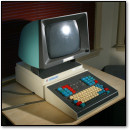[ Retro Scan of the Week ] Get Your Start in Color Computing with the TRS-80 MC-10
May 11th, 2015 by Benj Edwards SMALL ENOUGH TO FIT IN A DINOSAUR SHOE
SMALL ENOUGH TO FIT IN A DINOSAUR SHOE
I’ve owned a TRS-80 MC-10 since at least 1996 (according to this photo), so it holds a nostalgic place in my collection. It’s a really neat little machine despite its limitations (chief among those problems? Tiny chiclet keyboard). But Radio Shack designed this machine as a low-cost entry-level PC for the home, so most of of those issues can easily be overlooked.
The MC-10’s price at the time of this catalog printing had slipped to just $79 (about $178 today when adjusted for inflation). For comparison, the Apple IIc (a far more sophisticated machine, but typical for a home PC at the time) retailed for $1295 upon its introduction that same year (that’s a whopping $3,688 today). Price wise, that’s similar to the difference between buying a low-end Windows 8 tablet and a Mac Pro. The technological difference was not nearly that dramatic, however.
Perhaps the coolest thing about the MC-10 is that you can now download software for it over the Internet in the form of audio files and load them into the MC-10 via its cassette port. Check out this site for an awesome array of homebrew MC-10 games.
Discussion Topic of the Week: If you were stuck on a desert island and you could only use a TRS-80 MC-10 or a Sinclair ZX81, which would you pick?






May 12th, 2015 at 5:09 pm
I cut my teeth on the full size TRS Color Computer II, so I would definitely be sharing my desert island with the MC-10. I’ve never touched one but it sure looks cool! I’d almost rather have one of those than the brand spankin’ new Android tablet I ordered yesterday…
May 12th, 2015 at 6:35 pm
I’d go with the MC-10 due to the RS-232 communications port option.
May 12th, 2015 at 6:58 pm
As a kid I was never exposed to the small, super-low-cost machines like the TRS-80 MC-10 or the Sinclair ZX.
There was an unlucky kid on my street who owned a Commodore Plus/4. That machine was supposed to be Commodore’s $79 answer to the Sinclair. Unfortunately, the Commodore marketing folks decided they could put the same machine in a full-size case and charge $300+ for it, and the rest is history.
May 12th, 2015 at 8:17 pm
I’d go with the Tandy MC10 because it has a slightly better keyboard (chiclet instead of membrane), color graphics, sound and a built in RS232 port. Also, it looks like the MC10 has an actual power switch to turn it on or off, unlike the ZX81 which I believe powered up as soon as the power cable was connected to it.
The MC10’s casing also looks a bit more robust.
May 13th, 2015 at 2:47 am
If those were my only computing options, I think I’d choose death.
Failing that, the Tandy. For exactly the reasons Daniel listed.
Heck, the keyboard alone makes it a better deal. Membrane keyboards are the product of an inherently malevolent and misanthropic being… and someday the modern “all input is a touchscreen” mindset will come to the same conclusion we reached in the 80s: that tactile feedback, however slight, is a HUGE boon.
May 13th, 2015 at 9:02 am
I have owned a ZX81 since the the early 1980s, and have always liked the MC-10, though I never owned one. My first computer was a TRS-80 Color Computer — the original silver one with the chicklet keys). I’d probably choose the MC-10 for the reason the other Daniel stated: its color screen, sound, and RS-232 port. Still, the ZX81 was a fun computer, and I break it out every now and again. It’s kind of funny to see it hooked up to my 52″ HDTV.
May 13th, 2015 at 9:45 am
Here’s a twist that might make you pick a ZX81 over the MC-10. What if, in addition to the hardware, you were provided with a complete library of that machine’s software to go with it?
In this case, the ZX81 would give you a library of thousands (just guessing) of pieces of software (lots of games in there, albeit black and white), an the MC-10 would only have dozens of programs available. Would that tilt the scales in the ZX-81’s favor?
I should have made it a match up of the Sinclair Spectrum vs. the MC-10.
May 14th, 2015 at 11:57 am
Benj, I grew up spending more quality time with ZX81 and Spectrum-compatible machines than with humans so it’s hard to be objective on this one. Software library really brings an advantage to the ZX81 (in particular when you don’t consider homebrews – both had incredible things in this scene, but at the time the ZX81 library trounced the MC-10).
so it’s hard to be objective on this one. Software library really brings an advantage to the ZX81 (in particular when you don’t consider homebrews – both had incredible things in this scene, but at the time the ZX81 library trounced the MC-10).
Maybe if it was a little less deliberately incompatible with CoCo (e.g.: the graphics chip is the same, but it seems wired in a way that makes some screen modes harder to achieve; BASIC tokens were different with no apparent reason other than making it impossible to read Color BASIC programs from tape – which were otherwise readable; and so on), it would have had some chance as a fun entry-level machine. Sadly, as it was, I have to agree with this: http://www.atarimagazines.com/creative/v9n10/39_The_TRS80_MC10_too_lit.php – “too little, to late”.
May 17th, 2015 at 9:07 pm
Hard to say. More machine language games for the ZX81, but no real hires modes normally available. Today the MC-10 has a number of hires games:
Lost World Pinball
Space Assault
Pac-Man (One of the best homebrew copies of the original ever, by Greg Dionne)
Tetris (Greg D–with real voice sound effects)
Flagon Bird
And don’t forget it has a Chip-8 Emulator, so it also has a bunch of chunky 8-bit games from the 1970s (and modern home brews made for that classic language since then). I love the springy little chicklet keys of the MC-10. And of course there are all the BASIC homebrews I’ve made and ported to it;)
My hope in making them was to distill some of the greatest 8-bit classics…
May 25th, 2015 at 11:02 am
“I should have made it a match up of the Sinclair Spectrum vs. the MC-10. ”
That makes things a lot easier. MC-10 in a heartbeat.
In fairness, I have a deep-seated, irrational hatred of the Spectrum, and I pity every poor british child that had to suffer with one.
That it can be expanded out ridiculously far, that it has a software library that takes more than one shelf, that more than twelve people on Earth ever used one, that it was almost literally cheaper than the dirt outside the store it was sold in… all of that pales before the fact that it personally offends me.
I never claimed to be a rational human being.
June 3rd, 2015 at 2:31 pm
If I could have the TS-1500 I would simply because it has a better case / keyboard than both. The MC-10 is a solid little machine but Radio Shack went out of its way to cripple the device in order to keep it from cannibalizing the CoCo. And like all great cannibalization-deterrents they would up making a sub-par product (IBM PC Jr anyone?). The ZX81 was a hacker’s computer. They went for cheap but also went for open, so the platform was easy to hack and modify.
That’s why I have a MC-10 available if anyone wants it. I’ll gladly trade for a ZX-series machine.